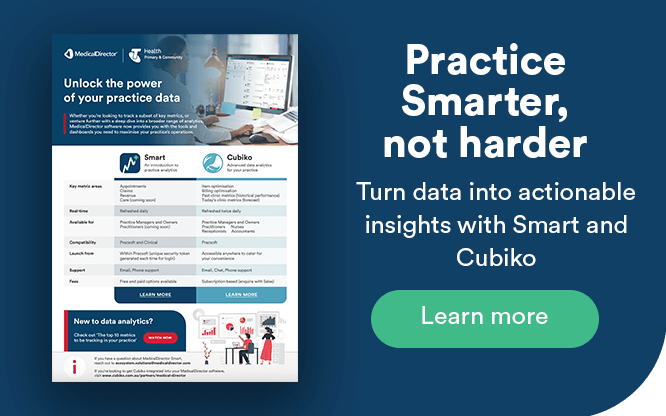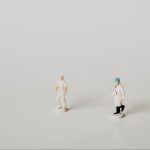3 Ways to improve your practice management IT
Complex, slow IT processes and systems slowing your medical practice down? We talk to three practice managers to find out how they improved their technology tools to transform the day-to-day workflow for staff and doctors.
1. Integrate clinical systems with practice management
Having separate clinical software and practice management systems, often means the two systems can’t ‘speak’ with each other, so information either needs to be entered twice, or it gets ‘lost’ in translation between the software. It’s a problem Practice Manager, Di Schultz, said the South Australian practice, South Road Day & Night Surgery faced when it first started out.
“In the very early days, we had a competing product which we thought would be right for us, but found that it was quite clunky and chunky,” she said. “We also had separate clinical and practice management systems, which was a challenge because nobody takes responsibility when things go wrong. That’s why we turned to MedicalDirector to find a better solution.”
In order to improve the practice’s IT infrastructure, South Road Day & Night Surgery turned to MedicalDirector’s Clinical and Pracsoft solutions, which integrate seamlessly together. Since switching in 2002, South Road Day & Night Surgery have enjoyed the workflow efficiencies of a far more seamless IT system.
“Switching to MedicalDirector and using it since 2002 has been a fantastic decision for us,” Di said. “I can’t speak highly enough of MedicalDirector and its software solutions, and I tell everyone they should have it. Clinical and Pracsoft integrate so seamlessly and fit together like a hand in a glove. The systems just flow so beautifully.”
2. Find a system that’s easy to understand
Complex IT systems that nobody understands wastes time, causes frustration and can potentially cost a practice valuable patient time. Finding a system that’s simple, intuitive and easy for staff to learn, means you get more out of your IT capability and ensure the software works harder for you.
When building a new medical practice of 30 doctors, 8 nurses, 8 receptionists, podiatrist and dietitian, the founders of Bondi Junction 7 Day Medical Practice wanted to leverage not only a tried and tested solution, but also software that the wider healthcare community knew and trusted.
“It was all about familiarity,” Practice Manager and Registered Nurse, Christina Dawson, said. “Everyone was already familiar with MedicalDirector and how it worked, and we liked its user-friendly interface. When we started to employ new doctors, the practitioners would already be familiar with MedicalDirector’s software systems.”
The practice also wanted to leverage a reputable software solution that was easy for new staff to be trained on – even those with limited computer or technical skills.
“I’ve trained new doctors, receptionists, and nursing staff on using MedicalDirector’s platforms when they first started and it’s quite easy for new staff to learn,” Christina said. “Even staff with limited technical skills could pick up MedicalDirector’s programs very quickly and proficiently.”
As a registered nurse, Christina said she’s used Clinical and Pracsoft both from a nursing perspective, and in her role as a Practice Manager of a busy medical centre. One of the key benefits she’s seen is that both platforms are easy to use and follow.
“I would recommend MedicalDirector’s Clinical and Pracsoft solutions for their ease of use, it’s easy to train people, and the language used is familiar and easy to understand. There are no complex technical terms, just simple terms like ‘progress notes’. This makes using and understanding the program flow easy.”
3. Small changes make a big difference
Take a look at the micro-moments of your day. What small, incremental changes can you make to help ease the pressure and work smarter, not harder? Bondi Doctors’ Practice Manager, Olivia Gomes, revealed how making just one improvement in their IT process, significantly reduced the admin burden and hassles of processing insurance medical information requests.
Since the inception of the practice in 2011, Bondi Doctors used both Clinical and Pracsoft by MedicalDirector as their go-to practice management solution. However, processing insurance medical information requests was still a time-consuming paper-based process.
With the traditional process, the request was either emailed or faxed to us, and the doctor would have to process it in paper form,” Olivia said. “The doctor would then have to type or freehand it. Then reception staff would have to print it, scan it or fax it. It was time-consuming for everyone involved.”
Bondi Doctors recently discovered the benefits of going paperless, with a simple UHG ‘widget’ integrated into MedicalDirector’s software. Using this tool has allowed the doctor to conveniently complete the insurance medical information requests, while being able to access relevant patient clinical information from within their MedicalDirector clinical management system.
“The great thing about the UHG widget is that because it is integrated into MedicalDirector’s software, it takes the information from the patient file and puts it directly into the report request, and the whole process is so streamlined and integrated – it’s great! Plus, the electronic consent recorded by the patient in the UHG widget is valuable as well because it gives us peace of mind that we’re also complying with patient privacy,” Olivia said.
Unlike traditional paper-based forms, where you need to send the insurance company an invoice, and it could take days or even a week for them to get back to the practice regarding a payment, electronic processing has taken the hassle away for both practitioners and their patients.
“When you send an email to UHG, they’re on to it straight away,” she added. “It’s usually a same-day request, and most of the time the account gets paid on the same day too, which is a much quicker turnaround time than paper form. And because everything is digital, and the doctor can literally do it on the same day as they see a patient, things get done a lot quicker and it doesn’t hold up patients’ insurance applications or claims. So, I believe this new process also greatly improves the patient experience.”










